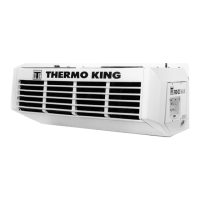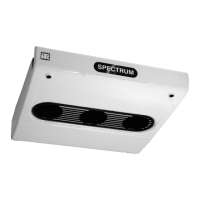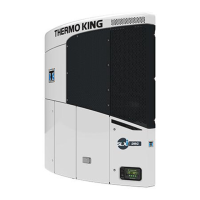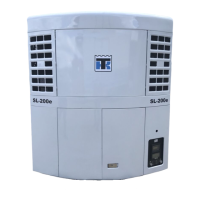Refrigeration Maintenance (Rev. 04/03)
68
Remove Evacuation Hoses
1. Run the unit in high speed cool with the receiver outlet
and discharge valves back seated.
2. Front seat the suction service valve and allow the com-
pressor to pump down to 3 to 5 psig (21 to 35 kPa).
Stop the unit. Remove the hose from the suction service
valve service port. Immediately install the cap on the
service port and tighten.
3. Back seat the suction service valve.
4. Remove the hoses from the receiver outlet and dis-
charge service valves.
5. Replace and tighten the service port and valve stem
caps.
6. The unit is ready for a functional check out.
REFRIGERANT LEAKS
Use a reliable leak detector (e.g., electronic detector) to leak
test the refrigeration system. Inspect for signs of oil leakage
which is the first sign of a leak in the refrigeration system.
NOTE: It is normal for compressor shaft seals to have a
slightly oily film.
REFRIGERANT CHARGE
Testing the Refrigerant Charge with an Empty Box
If the unit has an insufficient charge of refrigerant, the evap-
orator will be “starved” and the box temperature will rise
even though the unit is operating. The suction pressure will
drop as the refrigerant charge decreases. The charge may be
determined by inspection of the refrigeration through the
receiver tank sight glass with the following conditions
established:
1. Place a test box over the evaporator.
2. Place a thermometer (TK No. 204-135) test lead in the
box near the evaporator return air opening.
3. Install the gauge manifold.
4. Run the unit on Cool until the air in the box indicates 0 F
(-18 C). By allowing the box to leak a small amount,
you will be able to maintain 0 F (-18 C).
5. R-134a Systems—The discharge or head pressure
gauge should read 150 psig (1034 kPa).
R-404A Systems—The discharge or head pressure
gauge should read 275 psig (1896 kPa).
If the pressure is below this, it can be raised by cover-
ing a portion of the condenser coil with a piece of card-
board.
6. R-134a Systems—The compound gauge should be
indicating 0 to 2-1/2 psig (0 to 17 kPa) gauge pressure.
R-404A Systems—The compound gauge should be
indicating 13 to 18 psig (90 to 124 kPa) gauge pressure.
If there is any doubt about the unit gauge, check the
calibration.
7. Under these conditions, the ball in the receiver tank
sight glass should be floating.
Testing the Refrigerant Charge with a Loaded Box
1. Install a gauge manifold (optional).
2. Run the unit on the Cool cycle.
3. Cover at least three quarters of the condenser to drive
any excess refrigerant from the condenser into the
receiver tank.
4. As the head pressure is rising, check the receiver tank
sight glass. The ball should be floating. If there is no
indication of refrigerant in the receiver tank sight glass,
the unit is low on refrigerant.

